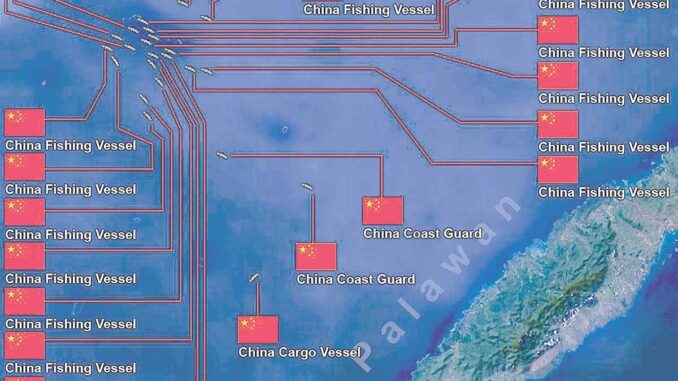
THE Philippine Navy on Tuesday logged the biggest number of Chinese ships seen in Escoda (Sabina) Shoal in the West Philippine Sea (WPS) weeks after the Philippine Coast Guard pulled its biggest vessel from the disputed area.
A total of 11 People’s Liberation Army-Navy (PLA-N) were sighted in the area from the period September 17 to 23, Rear Adm. Roy Vincent Trinidad, navy spokesman for the West Philippine Sea, said on Tuesday.
“This is the first time we have monitored that number [of ships] in Sabina,” Trinidad said in a press conference.
COURTESY OF MARITIME AWARENESS DAILY
Despite this, he maintained that China does not have de facto control of the area as the government will not be deterred from performing its mandate to safeguard Philippine territory.
“We continue to perform our mandate patrolling by sea and by air, not only in Escoda but in the entire West Philippine Sea,” Trinidad said when asked if the surge of warships meant that China now has de facto control of the shoal.
Trinidad gave no reason for the dramatic increase of Chinese vessels in Escoda Shoal and other areas in WPS.
“Historically, each time there is a weather disturbance, the numbers go down, and they come back after the weather disturbance,” Trinidad said.
Aside from the navy fleet, 16 China Coast Guard (CCG) ships and 55 Chinese maritime militia vessels were spotted in the area within the said period.
Also, a total of 251 Chinese coast guard ships, navy ships and maritime militia vessels were monitored in the West Philippine Sea from September 17 to 23, which is the biggest total so far.
After more than five months, the BRP Teresa Magbanua left Escoda Shoal for the port of Puerto Princesa, Palawan, on September 15.
At least four dehydrated crew who subsisted on rice porridge and rainwater weeks before as CCG thwarted the arrival of supplies for them were immediately brought to a hospital for treatment.
Escoda Shoal serves as the rendezvous point for Filipino vessels carrying out resupply missions to the naval outpost in Ayungin (Second Thomas) Shoal, where the naval outpost BRP Sierra Madre, which is a main flashpoint of tensions between Manila and Beijing, has been aground since 1999.
The number of Chinese ships spotted in the West Philippine Sea (WPS) from September 17 to 23 has climbed to 251, higher than the 157 vessels detected from September 10 to 16, the Philippine Navy (PN) said in a report Tuesday.
This is the highest concentration of Chinese ships in the WPS so far this year, the Navy said.
Earlier, a Chinese military helicopter was reported to have trailed a plane carrying members of the Bureau of Fisheries and Aquatic Resources over the Panatag Shoal in the West Philippine Sea.
The Chinese Harbin Z-9 helicopter began trailing the BFAR plane at an unsafe distance on Monday.
This prompted the Filipino pilot to respond, warning that its intrusive actions were “endangering the safety of our crew and passengers.”
The helicopter, however, closed in to a mere 6 meters from the BFAR plane, escalating the danger. China’s naval and air forces were reportedly operating the said chopper from a warship with a helipad, which was spotted about 25 nautical miles east of the shoal.
Trinidad branded as “unprofessional” and “unsafe’ the way by which the Chinese military helicopter tailed the BFAR air patrol of Bajo de Masinloc in the WPS.
“These are unsafe maneuvers. They are uncalled for, unprofessional,” he said in a press briefing.
He said they are leaving it to the BFAR to issue the “appropriate official statement” on the incident last September 21 involving a Chinese Harbin Z-9.
Trinidad said tailing or getting too close to another aircraft increases the potential for any untoward incident and poses a danger for the pilots and passengers.
He said such actions have no place in aviation and that rules of engagement and international law should be followed.
“Not only for aircraft but even for ships. Hence, the need for all the actions to be within the rules of engagement and international law,” Trinidad said.
Trinidad said the government is considering all its options in resolving the continued Chinese encroachment in the WPS.
“There are many approaches that could be taken. We haven’t exhausted all approaches [yet],” he said.
He denied that continued Chinese presence in the WPS, especially in Ayungin and Escoda Shoals, constituted a “form of limited sea control” or a “blockade.”
“No. I call them as illegal presence, coercive and aggressive actions, and deceptive messaging,” Trinidad said.
“At the highest level of government, there are a range of different options available. These options have not been exhausted yet. The AFP (Armed Forces of the Philippines) has a particular role to play under the whole-of-government effort,” Trinidad said. “Whatever is decided upon, the AFP will implement.”
He clarified that the Philippine military did not lose its presence in Escoda Shoal despite the departure of the Philippine Coast Guard’s BRP Teresa Magbanua (MRRV-9701) on September 14.
“We have always been there. The objective is monitoring. Again, [as] I mentioned, this is not just physical. There are different capabilities that we have right now to be able to monitor not only Escoda but the entire WPS,” he added.
Trinidad said monitoring the area could be done on sea, land or through space-based systems, noting that the Navy would not be deterred in going about its regular routine.
“We’ll keep performing our mandate and keep monitoring our shoals and reefs and shallow areas,” he added.
Also on Tuesday, the Philippines dispatched one of its ships to monitor the activities of a Chinese survey ship that was spotted off Rio Tuba in Palawan on Monday and was escorted by a number of Chinese maritime militia vessels.
Based on monitoring by SeaLight, the PCG offshore patrol vessel BRP Cape Engaño began shadowing China’s survey ship Haiyang Dizhi 12 Hao and its escort of six maritime militia ships.
“The flotilla is now in its second full day off the Philippines’ coast, having now doubled back to the NW within 40nm of the Palawan coastline,” said retired US Air Force Col. Ray Powell, director of SeaLight.
Commo. Jay Tarriela, PCG spokesman for the West Philippine Sea, also confirmed the reports.
Tarriela said the Chinese flotilla sailed as near as 25 nautical miles off the Palawan coastline on Monday.
“That is true. I would like to confirm that the Philippine Coast Guard vessel has been deployed to carry out patrols to prevent this kind of uncoordinated [maritime scientific research] without permission from the Department of Foreign Affairs,” he said.
WITH PNA





Be the first to comment